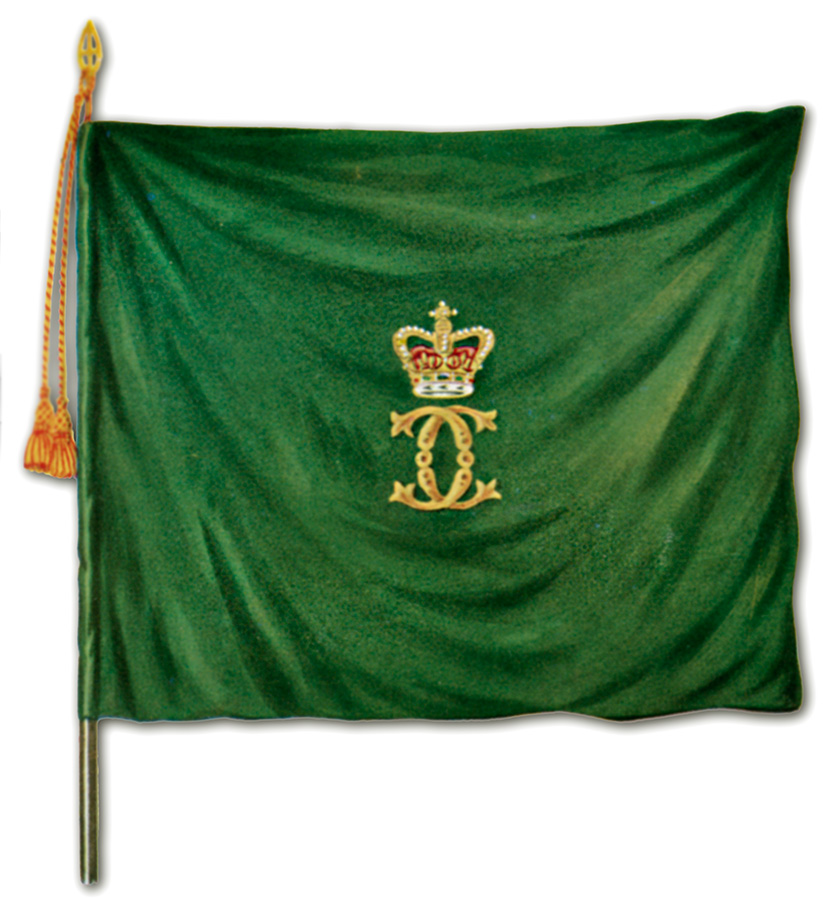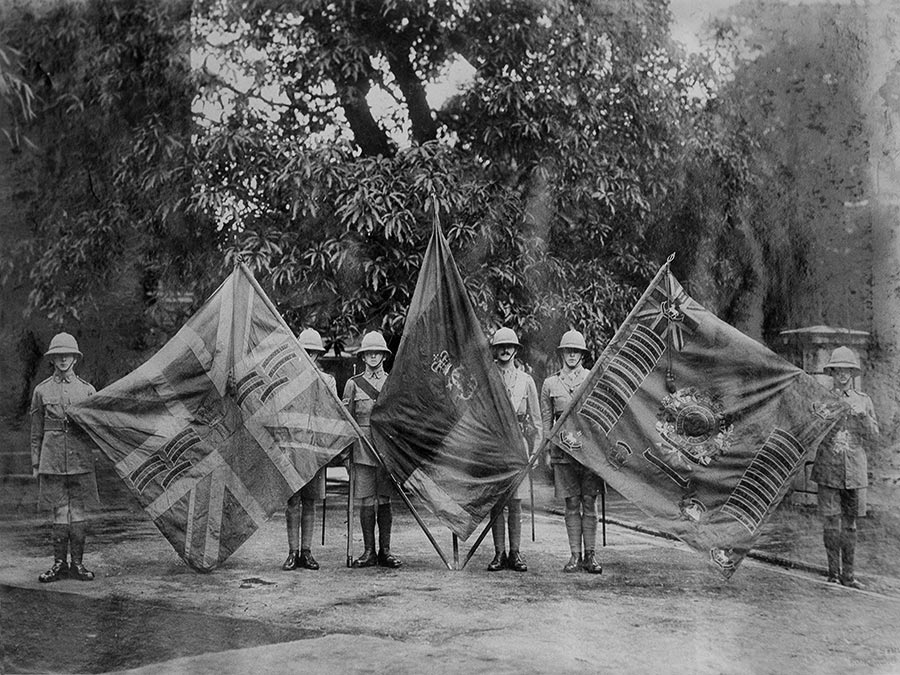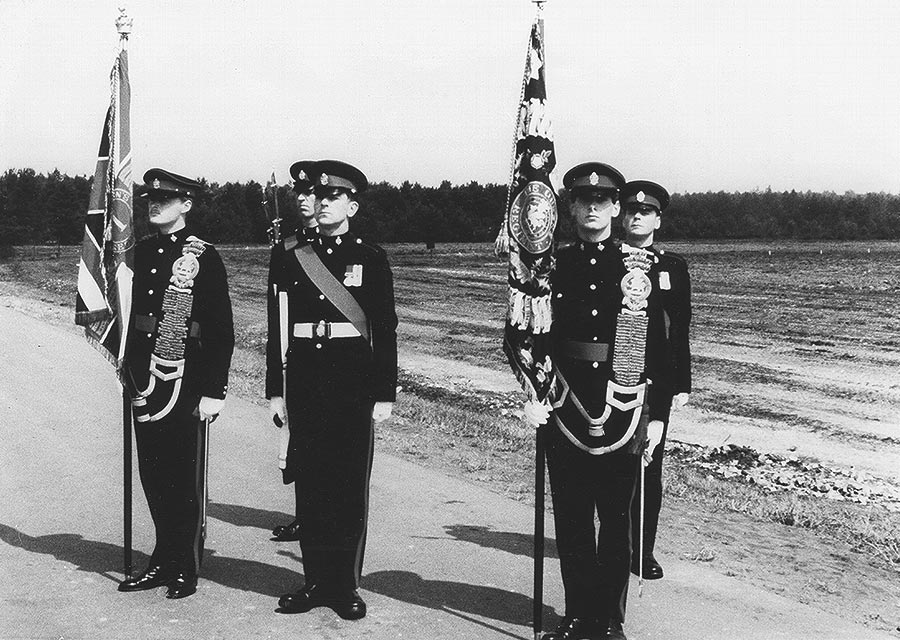The Colours of The Second or Queen’s Royal Regiment
The Third Colour
The unique distinction of the Regiment in bearing a Third Colour has been the subject of much discussion over the last 150 years. As has already been stated, the Regiment carried ten Colours in 1686 (Royal Warrant 21st August 1686, College of Arms). After the infantry reorganisation of 1707, the Colours were reduced to three, and St Andrew’s saltire was added to the Union. The next reduction came in 1747 when infantry Colours were reduced to two. The Clothing Regulations of 1747, which can be seen in the General Officers’ Letter Books for 1742 – 1757 held among the War Office papers in the Public Record Office, also forbade Colonels of Regiments from displaying their own Arms on Colours and for the first time specified what numerals and distinguishing badges each Regiment might display.
“it had been erroneously considered that the Regiment had a peculiar privilege of carrying three stand of Colours.”
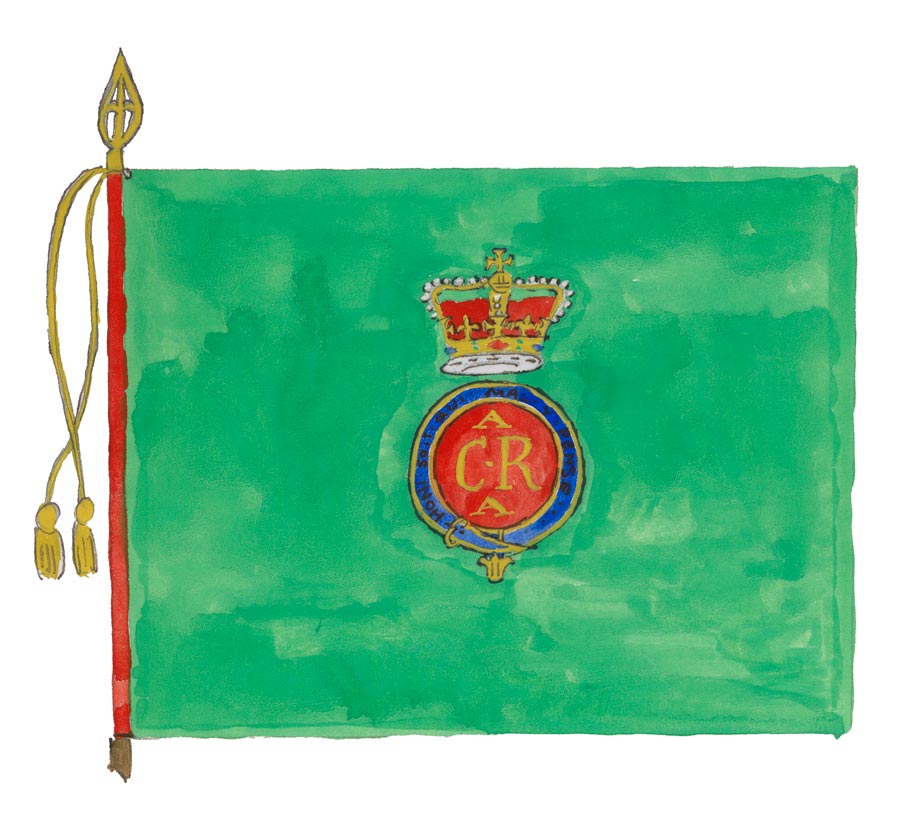 |
| Figure 24 (Click to enlarge) |
Milne’s and Cannon’s view is a highly likely explanation of the state of affairs. Colonel John Davis, however, in his History of The Second Queen’s (London, 1887) disagrees and advances the view that first, the third Colour had been retained in consequence of having been presented by Queen Catherine and secondly because although a Royal Regiment, The Queen’s had retained green facings instead of changing to blue. There is little if anything to support this theory. There is no documentary evidence to suggest that Queen Catherine ever presented Colours to the Regiment, nor is the fact that the Regiment kept green facings any ground on which to base a deliberate disobeyal of an Army Regulation.
Whatever the reason, the Regiment retained its third Colour and in 1749 its long tour of duty in Gibraltar came to an end and it moved to Ireland. Four months later the Adjutant General issued new instructions on clothing and Colours already mentioned, which stipulated that each regiment was to have two Colours only, and no colonel was permitted to display his own arms, device or crest on regimental Colours or other appointments. In January 1750 the Regiment marched into Dublin with three Colours flying, clearly oblivious of any irregularity. These three Colours were described by Ensign Donkin, later Major General R Donkin, who was carrying the Third Colour, in his Military Collections and Remarks (London, 1777) thus:
“His Majesty’s arms were in the centre of the first. The Queen’s cipher in the centre of the second, both of which were in other respects unions. The Third Colour was then green (the original facings of the corps) and to the best of my recollection the colonel’s arms or crest was in the centre.”
It has been suggested that the first and second Colours were the old Lieutenant Colonel’s and Major’s Colours of 1686, which is quite possible but it should be noted that the 1686 Colours were green, with a red cross bordered white whereas by 1750 “the Union” would have taken the form of the red cross of St George bordered white on the white and blue saltire of St Andrew. These could therefore be new Colours although there is again no record of such Colours having been presented between 1686 and 1750. More likely that the old Colours, worn and tattered by campaign service, were patched and reworked to conform to new patterns. The third Colour is another matter. Donkin states that the Colour bore the Colonel’s arms in the centre. This must be open to question for a number of reasons. First, Donkin was writing twenty-seven years after the event and human memory is notoriously tricky. Secondly, The Queen’s were particularly distinguished by their title and were proud of it. They had always displayed the Queen’s cipher and it seems unlikely that the Arms of the Colonel would have been given precedence over the Royal cipher of Queen Catherine. Thirdly, since 1686 the Regiment had served on a strenuous campaign in Ireland, in the Low Countries, in Spain and had undertaken a twenty-nine year tour of duty in Gibraltar. The condition of the Colours after this time can only be guessed at but it is probable that so worn were they, that any badge would be difficult to make out. This points strongly therefore to Donkin’s third Colour being the original Colonel’s Colour of 1686.
At this point, official policy reasserted itself. On seeing the three Colours, the Colonel of the Regiment, General Fowke, ordered that the third Colour should be withdrawn at once. To the chagrin of the Regiment which, as Donkin states, believed the third Colour to be a special privilege, it was at once taken away and was laid up in the chapel of the Royal Hospital at Kilmainham, near Dublin. Donkin wrote of its removal:
“. . . the Third Colour was, by order of General Fowke (then Colonel of the Regiment), taken out of my hand, furled and never flew since. The men grumbled exceedingly at being deprived of an honour no other Corps then enjoyed.”
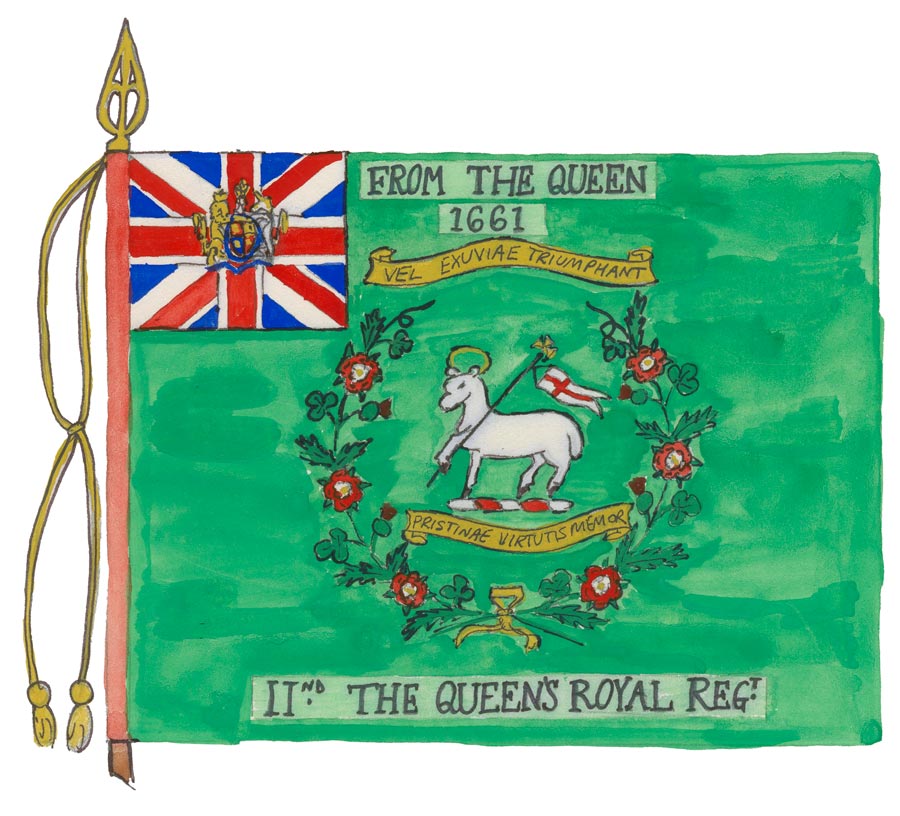 |
| Figure 25 |
| Design of the Torrens Colour 1825-1853 from the Garter King of Arms MS. (Click to enlarge) |
For the next seventy-four years the Regiment bore only the two Colours of any line regiment once the third Colour had disappeared, not much thought was taken of it, until the advent of Sir Henry Torrens. Torrens had been a Major General in 1814 at the age of 35, was Adjutant General of the Army in 1820 and Colonel of The Queen’s in 1822. Visiting the Regiment in 1824 – it was once more at Dublin – he heard of the old third Colour lying nearby and decided to petition the King for its return to the Regiment. In preparation, he withdrew the Colour from Kilmainham and returned with it to England, followed soon afterwards by the Regiment which moved to Chatham.
In due course, King George IV approved the restoration of the third Colour to the Regiment, as “a mark of His Majesty’s most gracious favour” – no doubt Torrens’s position as Adjutant General was most advantageous. There were, however, problems. The old third Colour was now so ragged that nothing could be made of its design. Instead of consulting the Royal Warrant of 1686, it appears that Torrens invented a new design, shown in figure 25, and submitted a copy to The College of Arms where it is still held. Lady Torrens herself worked diligently on the restoration of the old Colour for months, which was now quite different from anything which had appeared before. The Garter King of Arms’ paper, submitted by Torrens, describes it thus:
“. . . in the centre of the Third Colour of sea green within a wreath of roses, thistles and shamrock, The Paschal Lamb surmounted by the words From The Queen 1661 and bearing the mottoes above specified. [Vel Exuviae Triumphant and Pristinae Virtutis Memor]. In the dexter canton the Union with the Royal Arms, Crown and Supporters.”
There is a series of major inconsistencies here: first, Queen Catherine did not arrive in England and become Queen until 1662, after the Regiment had sailed for Tangier. Secondly, of course, there was no single Tangier Regiment until 1668, after four regiments and remnants of four others had been amalgamated together following heavy losses. Finally the Tangier Regiment is not described as The Queen’s until after its return to England in 1684.
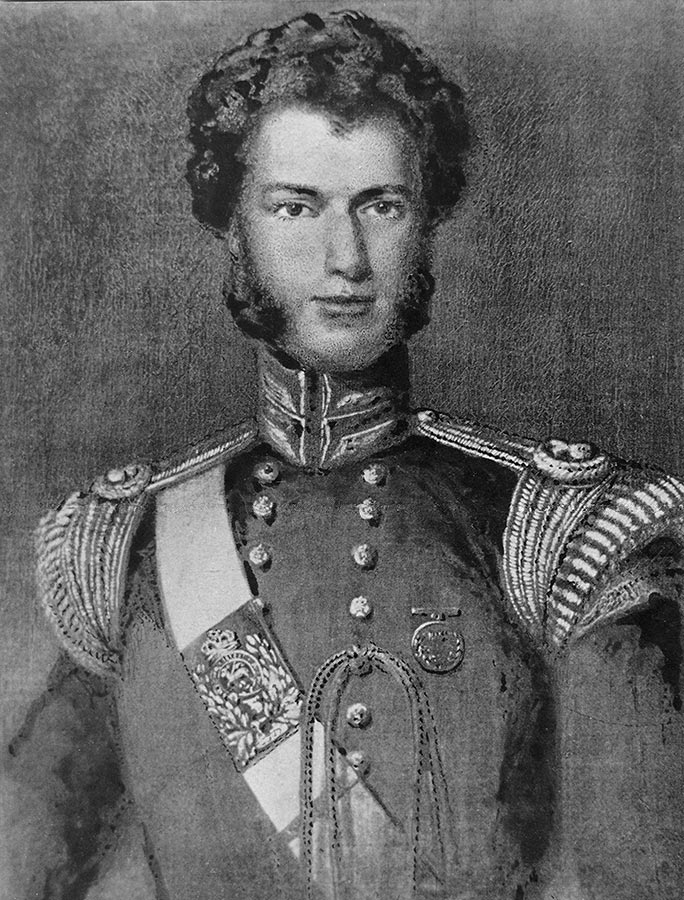 |
| Figure 26 |
| Lieutenant George Dalhousie Raitt. (Click to enlarge) |
The restored Colour, however, was duly presented to the Regiment at Chatham on 31st January 1825, appropriately by Lady Torrens herself. The ensign was Lieutenant George Dalhousie Raitt – see figure 26.
The Regiment was not long to enjoy the fullness of the Colour’s restoration. It happened that the 5th Fusiliers had the distinction of a third Colour – although this was a battle honour, not an original relic of the seventeenth century. When this regiment was at Gibraltar in 1833, all its Colours were destroyed in a fire, and when they were replaced in 1835, King William IV refused to authorise the replacement of a third Colour. On enquiring if any other regiment had such a distinction he was told of The Queen’s, and amended his brother’s ruling so that no regiment should be permitted to display a third Colour under any circumstances whatsoever. This ruling was tempered by the concession that the Colour need not actually be withdrawn so long as it was not displayed in the ranks of the Regiment. For some years after this, interest in the Colour lapsed.
Interest was revived, however, in 1853 when the then Commanding Officer of The Queen’s, Colonel Burns, ordered a replacement Colour from a firm in Cape Town, the old Colour being now much decayed. Burns consulted the College of Arms for a design and was given Torrens’ sketch and description. Using this, a new Colour was made like that of 1825. Moreover the firm in Cape Town used the centre portion of the 1825 Colour to be incorporated in the new. This Colour was lent to a Naval and Military exhibition at Earls Court in London in 1891. This Colour continued in service until 1894, when it was despatched from Malta by registered post to the Depot at Guildford, and from thence laid up at Holy Trinity Church, Guildford, on 29th September 1894; however the pike and spearhead were retained at Malta and used for the replacement. It was later moved to the Regimental Museum, much tattered, where Mrs Jean-Anne Stock worked on the fragments and saved a good portion of the embroidery, which was returned to the care of the 1st Battalion after a lapse of ninety-two years. One can clearly make out the lamb, surrounded by its wreath; the union with the Royal Arms, Crown and Supporters; the two mottoes and the words “From The Queen 1661”. In addition there appears to be a crowned harp, the distinguishing badge of British Ireland, which must have been added at some stage for reasons unknown. An extant sketch of the Burns Colour is shown as figure 27.
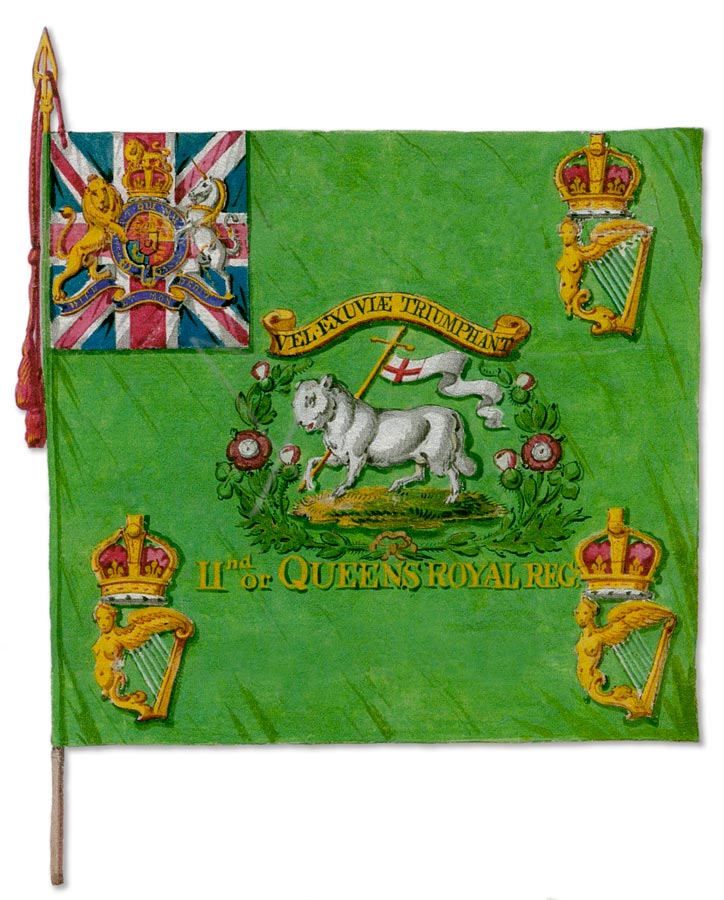 |
| Figure 27 (Click to enlarge) |
In the previous year, 1893, Lieutenant Colonel EF Broderick had taken over command of the 1st Queen’s in Malta and had communicated with the Regimental historian, Colonel John Davis, in order to replace the old Colour with one as close as possible in design to the original. This Colour, known as the First Malta Colour, reverted to the original design of 1686 – plain green with the interwoven cipher of Queen Catherine surmounted by a Royal Crown as shown in figure 28. It was woven at the Royal Art School of Needlework, Kensington. This design has been followed ever since. It was this Colour which, in defiance of the old order, was carried at the King’s Birthday Parade in Hong Kong in 1927, as shown in figure 29. No censure followed, and the occasion is especially worthy of note in that the Colours on parade were the same Colours carried by the battalion on its last visit to China in 1860. Official notice was, however, incurred for in 1933, the King reiterated the order that third Colours should not be carried on parade, except, cased, on a change of station.
The central portion of this Colour is now preserved in the Regimental Museum whence it was taken after thirty-six years’ service, being replaced by the Second Malta Colour. The 1st Battalion was once again in Malta and the old Colour being much worn, Colonels Clark and Ponsonby presented a new Colour which made its first appearance in the Officers’ Mess on 30th June 1930. The green silk was supplied by Liberty’s of London and the cipher was embroidered by the Franciscan Missionaries of Mary at Casa Balzan, Malta.
The Third Colour
Figure 28
(Click to enlarge)
In early days each company carried a Colour and in 1686 King James Il authorized payment for ten Colours for the Regiment. In 1750 these had been reduced to three of which the Third was sea green (the colour of the original facings of the Regiment) with the Colonel's arms in the centre. |
| Figure 29 | Figure 30 |
| Colour Party, Hong Kong, 1927 | The Queen’s Silver Jubilee Parade, Sennelager, Germany,
1977 From left: Lt N H Carter, WO2 N Jamieson, WO2 V D Ebbens, Lt H W R Eagan, WO2 J Budgen |
| (Click to enlarge) | |
 |
| Figure 31 |
| Major General M F Reynolds CB, last Colonel of The Queen's Regiment, saluting the Third Colour at the disbandment parade of 1st Queen's, Minden, Germany, 1992. |
In 1977 the 1st Battalion was in Germany and was to take part in the Silver Jubilee celebrations of Queen Elizabeth II. The old Second Malta Colour was now so patched and tattered so that the Commanding Officer, Lieutenant Colonel JGW Davidson, ordered a new Colour from a firm in India. The old Colour was given into the care of the Warrant Officers’ and Sergeants’ Mess of the 1st Battalion and the new Colour, after a Service of Blessing, made its first appearance at the Silver Jubilee celebrations at Sennelager.
The Davidson Colour continued in service with the 1st Battalion under the authority of King George IV’s Royal Warrant of 1825. At the disbandment parade of the 1st Queen’s in 1992, the third Colour was returned to the care of the Colonel of the Regiment, Major General MF Reynolds CB, as shown in figure 31. Subsequently, it passed to the 1st Battalion of the new Princess of Wales’s Royal Regiment.
Related
